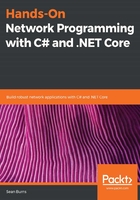
HTTP – application to application communication
Welcome to the bread and butter of almost every .NET Core developer working today. HTTP is by far the most common and useful protocol for applications to interact over networks currently in use today. Why is that? Because HTTP is the protocol that almost every single web page on the internet is served up on by remote hosts, and requested by local clients. That alone is reason enough to call it the most common protocol in use. If you want more evidence, though, consider that most native mobile applications that serve up web-hosted data request this data from APIs that are exposed via HTTP. It almost feels ridiculous to have to make a case for the importance of understanding HTTP, since I'm certain there won't be a single person reading this book who doesn't have at least some experience with, or understanding of, HTTP.
So, why bother covering it so thoroughly if most of my readers are assumed to have some basic understanding of it? The answer to that is twofold. First, it's because it is so common as a communication protocol! HTTP is so prevalent that it would be criminally negligent not to give it due consideration in a book purporting to teach network programming fundamentals. And the second reason is because, at least in my own personal experience, most developers, and even engineers who work with it daily, only have a passing or surface-level understanding of what the specification provides. My hope is that by the end of this book, anyone who has read it, cover to cover, can and will go forth and program software that leverages every aspect of their target networks confidently and competently. It wouldn't be possible to do that without a deep, thorough understanding of what HTTP is, why it was defined, and how it is used by thousands of applications every second of every day. With that in mind, let's take a look at the protocol.